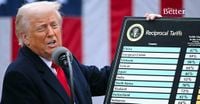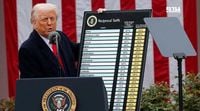On April 2, 2025, President Donald Trump unveiled a bold new tariff initiative aimed at reshaping America's trade relationships, particularly with countries in Southeast Asia. This announcement, made during a speech at the White House's Rose Garden, introduced what Trump termed "reciprocal tariffs" as part of his broader strategy to "Make America Wealthy Again." The new tariffs, which he referred to as "Liberation Day," are set to significantly impact trade dynamics, especially with Thailand, which will face a hefty 36% tariff on imports.
Trump's aggressive trade policy is designed to address longstanding trade imbalances that he argues have disadvantaged American workers and industries. He accused Thailand of imposing tariffs as high as 72% on U.S. goods, claiming that the new tariff structure would reduce the U.S. trade deficit with Thailand by approximately $4.6 billion. This measure is part of a wider effort that also affects other ASEAN nations, with Cambodia facing a 49% tariff, Vietnam 46%, and Indonesia 32%, among others.
In his address, Trump emphasized that the U.S. has been "robbed" for decades by unfair trade practices, stating, "For too long, our country has been taken advantage of by both friends and foes alike." He asserted that these reciprocal tariffs would not only rectify trade imbalances but also boost domestic manufacturing, which has seen a decline from 28.4% of global manufacturing in 2001 to just 17.4% in 2023.
The implications of Trump's announcement have sent shockwaves through global markets, with European and American stock markets experiencing volatility immediately following the speech. Investors are concerned that such tariffs could ignite a trade war, further complicating already fragile economic conditions. The tariffs are expected to create new barriers for consumers and businesses alike, potentially leading to higher prices for everyday goods.
Trump's plan includes a basic 10% tariff on all goods imported into the United States, effective April 5, 2025, with higher rates for specific countries and products. For instance, goods imported from China will incur an additional 34% tariff on top of the existing 20%, bringing the total to a staggering 54%. The President's administration has indicated that these tariffs are a necessary response to the high tariffs and non-tariff barriers imposed by other nations.
As part of this initiative, Trump also announced that discussions regarding the impacts of these tariffs on approximately 60 countries will take place on May 9, 2025. This includes a focus on how these tariffs will affect various sectors, including logistics, raw materials, and digital assets. Analysts have warned that the repercussions could lead to a significant slowdown in the global economy, raising the cost of living for American families by thousands of dollars annually.
Trump's administration has been clear about its intentions, stating that the tariffs are not merely punitive but are aimed at creating a more equitable trading environment. "These tariffs are designed to protect American jobs and ensure that our manufacturing sector is not left behind," Trump declared, highlighting the importance of reducing reliance on foreign manufacturing.
However, the announcement has faced criticism from economists who argue that such tariffs could backfire. Concerns have been raised that increased prices on imported goods could lead to inflation, harming consumers and small businesses. Furthermore, Trump's decision to impose tariffs on key trading partners like the European Union and Japan, which will face tariffs of 20% and 24% respectively, has raised eyebrows among international trade experts.
The President's stance is clear: he believes that imposing reciprocal tariffs is a legitimate response to the unfair practices of other countries. He argues that this approach will not only protect American jobs but also stimulate domestic production. "We cannot allow other countries to dictate our economic future, and these tariffs are a step towards reclaiming our economic sovereignty," Trump stated.
In addition to the tariffs, Trump has also targeted loopholes in trade regulations, such as the "de minimis" rule that allowed low-value packages from China to enter the U.S. without tariffs. This loophole, which has been exploited by drug traffickers, will be closed as part of the new trade measures.
As the world watches closely, the repercussions of Trump's new tariff regime will unfold in the coming weeks and months. The potential for retaliation from affected nations looms large, with many analysts predicting a tit-for-tat escalation in trade barriers. The stakes are high, as the global economy grapples with the implications of this new era of protectionism.
In summary, Trump's announcement marks a significant shift in U.S. trade policy, aiming to protect American industries and workers at the cost of escalating tensions with key trading partners. As the situation develops, the effects of these tariffs on both domestic and global markets will be closely monitored, with many hoping for a resolution that avoids a full-blown trade war.





